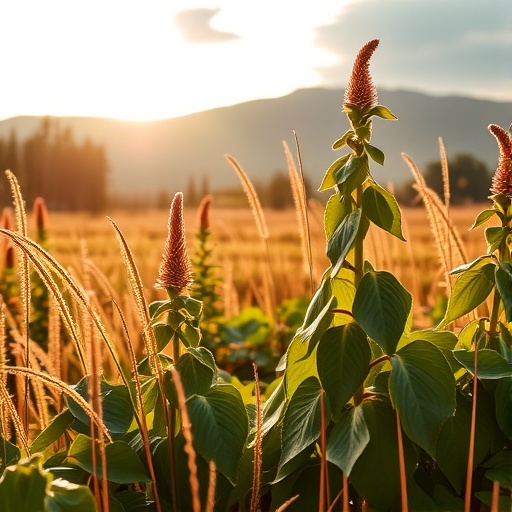Recent research has unveiled alarming findings regarding the impact of invasive C4 plants on soil greenhouse gas emissions. The study led by Gu et al., published in Communications Earth & Environment, provides critical insights into how different photosynthetic pathways in plants influence carbon cycling and consequently the greenhouse gas emissions from soils. This research comes at a time when understanding the ecological ramifications of invasive species has never been more pressing.
C4 plants, characterized by their unique photosynthetic process, have been shown to outcompete native C3 plants in various ecosystems. These plants, which include species such as maize, sugarcane, and several tropical grasses, have adaptations that allow them to thrive in warm environments with high light intensity. However, the study highlights that their proliferation could lead to a significant increase in soil-derived greenhouse gases, namely carbon dioxide (CO2) and methane (CH4).
The researchers conducted field experiments to measure soil gas emissions, assessing the carbon cycling processes associated with C4 and C3 plants. The results were striking; the invasive C4 species generated notably higher levels of CO2 and CH4 emissions compared to their C3 counterparts. This was attributed not only to the physiological differences in photosynthesis but also to the differences in root biomass and decomposition rates of the organic matter in the soil.
Moreover, the team employed advanced techniques to analyze soil samples, which included gas chromatography for quantifying emissions and isotope analysis to trace carbon sources. The study effectively draws a connection between plant types and the efficiency of soil carbon storage, showing that the invasion of C4 plants can disrupt the delicate balance of carbon cycling in ecosystems previously dominated by C3 vegetation.
The implications of these findings extend to climate change mitigation strategies. As greenhouse gases are significant contributors to global warming, regions experiencing invasions by C4 plants may face heightened challenges in managing their emissions. This reinforces the importance of monitoring invasive species and implementing control measures to protect native ecosystems and their carbon storing capabilities.
Additionally, the research has raised pivotal questions about land management practices. Understanding the dynamics between plant types and greenhouse gas emissions necessitates a reassessment of agricultural and forest management techniques. Farmers and land managers might need to develop strategies that minimize the spread of invasive C4 species while promoting the health of native C3 plants that inherently contribute to lower emissions.
The carbon cycle plays a critical role in regulating Earth’s climate, and disturbances caused by invasive species can reverberate through this system. Gu et al.’s work points to the necessity of interdisciplinary approaches combining ecology, climate science, and land management to tackle the challenges posed by invasive plant species.
Equally troubling is the potential for feedback loops resulting from increased greenhouse gas emissions. If C4 plants lead to higher emissions, this could enhance global warming, further favoring the spread of invasive species that thrive under warmer conditions. This warming could also affect biodiversity, as native species may struggle to adapt to the changing climate.
In conclusion, the findings presented by Gu and colleagues illuminate the complex interactions between plant physiology and ecosystem dynamics in the context of climate change. As researchers delve deeper into understanding these relationships, it becomes increasingly evident that integrating invasive species management into climate action plans is critical. The time for decisive action is now, as the battle against climate change intensifies and the consequences of neglecting invasive species become clearer.
Ultimately, the research underscores the need for a holistic view of ecosystem health, recognizing that every species plays a role in the intricate web of life and climate regulation. By addressing the threats posed by invasive C4 plants, we can better safeguard our planet’s future and promote resilience against climate change.
Understanding the implications of this study is vital for future research where scientists must explore not only how to manage invasive species but also how to enhance the carbon sequestration potential of native ecosystems. This represents a significant opportunity for conservation efforts aimed at restoring ecological balance and mitigating climate change effects.
As this research circulates within the scientific community, it is likely to inspire further studies and dialogue surrounding plant invasions and greenhouse gas emissions. The momentum created by such findings can galvanize policy changes and community action, propelling society towards more sustainable practices in land management and agriculture.
In summary, the work of Gu et al. sheds light on a critical, yet often overlooked, aspect of ecological research. By highlighting the role of invasive C4 plants in exacerbating greenhouse gas emissions, this study calls attention to the immediate need for informed conservation practices and innovative land management strategies that align with climate goals. The future of our planet may very well hinge on our ability to navigate these complex ecological challenges.
Subject of Research: The impact of invasive C4 plants on soil greenhouse gas emissions.
Article Title: Invasive C4 plants cause greater soil greenhouse gas emissions than C3 plants.
Article References:
Gu, Z., Zhou, L., Fu, Y. et al. Invasive C4 plants cause greater soil greenhouse gas emissions than C3 plants. Commun Earth Environ 6, 936 (2025). https://doi.org/10.1038/s43247-025-02844-7
Image Credits: AI Generated
DOI: https://doi.org/10.1038/s43247-025-02844-7
Keywords: Invasive plants, C4 photosynthesis, greenhouse gas emissions, carbon cycle, climate change, land management.




